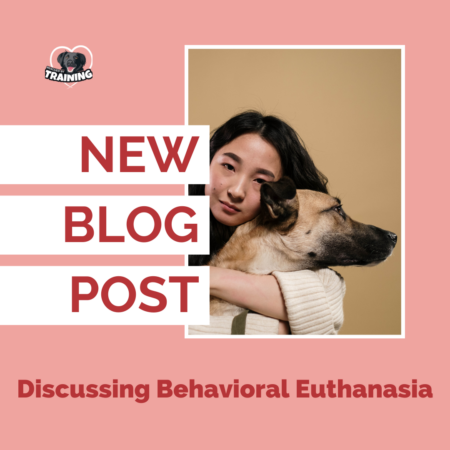As someone who specializes in fear and aggression cases, a few times a year, I have clients who are facing the consider of rehoming, surrendering or behavioral euthanasia. I am also a certified companion animal end-of-life death doula, so I am uniquely qualified to help you navigate these difficult times.
Behavioral euthanasia is touchy topic and one that tends to bring out the keyboard warriors. But stick with me. Euthanasia for any reason is a difficult decision but behavioral euthanasia is often not given the same understanding as a euthanasia for physical reasons like cancer or arthritis. Here we have a parallel with human healthcare – mental health struggles are often not given the same weight and empathy as physical ailments.
Nobody gets a dog thinking they may have to consider behavioral euthanasia. Despite the stigma it carries, it is not a decision made out of convenience. And it doesn’t necessarily mean the dog has mauled someone or police have been involved. Opting to euthanize for a dog that has seriously injured or killed a person or animal seems reasonable to many people but often behavioral euthanasia is done before there is serious harm. The decision about behavioral euthanasia is often about risk assessment and quality of life, for both the animal and the humans. And this is where it gets tricky, because it’s not black or white, and everyone’s risk assessment, is different.
But we know this. Nobody would speak badly about a person who opts to euthanize an animal struggling daily with pain and suffering which affects their quality of life from cancer but if that same animal is struggling with quality of life issues due to behavioral reasons, the owner is often shamed for considering behavioral euthanasia. This needs to change. Behavioral euthanasia not a decision made out of convenience.
Behavioral euthanasia is the humane ending of a dog’s life because the dog is suffering from severe behavioral issues, including aggression, fears or anxiety. It is a difficult decision for any dog owner to make, but it is sometimes the best option for both the dog and the family.
There are many reasons why a dog may be considered for behavioral euthanasia. Some of the most common reasons include:
- Aggression: Dogs that are aggressive towards people or other animals are a safety risk. They can cause serious injury or in some cases, even death.
- Extreme anxiety: Dogs that are severely anxious may be self-harming or unable to cope with everyday situations, such as going for walks or being around other people.
- Other behavioral problems: Other behavioral problems that may lead to behavioral euthanasia include severe separation anxiety, compulsive disorders, and self-mutilation.
The decision to euthanize a dog for behavioral reasons is not an easy one and often is met with a high degree of judgement, as if every behavioral situation can and should be “fixed.” But this thinking is overly optimistic at best and misses the mark on understanding where fear comes from in dogs. Poor breeding, lack of good, early socialization, environment and many other factors contribute to a dog’s mental health. It is important to weigh all of the factors involved, including the dog’s behavior, the safety of the family and community, and the dog’s quality of life.
If you are considering behavioral euthanasia for your dog:
- Ensure everyone’s safety by using physical barriers like baby gates and/or a muzzle until a decision is made.
- Talk to your veterinarian or veterinary behaviorist to rule out medical causes and explore medication options.
- Work with a qualified behavior consultant (like me!) who can help you navigate training options, prognosis, management or other options.
- Be transparent and honest with your behavior professional and vet so they can help you assess the situation and guide you to make the best decision for your dog.
- Schedule my special training session to help you navigate these tough decisions in a safe, non-judgmental space. You don’t have to, and shouldn’t, navigate this alone. There is help.
- Get support from a professional trauma therapist.
- Be kind to yourself. You’re acting out of love in any decision you make.
You can also download my free checklist here.
It’s important to give yourself grace and understanding during these times. Losing a pet is always difficult, but it can be especially challenging when the pet is euthanized for behavior. There’s often stigma, judgement and lingering questions about whether you did everything you could have. Talk to your friends and family about your loss, being honest and seek professional help, if you need it. And most importantly, allow yourself time to grieve. Remember that you made the best decision for your dog to give them peace for an animal whose quality of life was suffering.
Here’s some grief resources, including some specifically for behavioral euthanasia. Consider scheduling a photography session before you say good-bye. The Tilly Project – End-of-Life Pet Photography is a non-profit that helps photographers who specialize in this meaningful work connect with pet guardians. Check them out!
Navigating Quality of Life Decisions
- Euthanasia Considerations
- Losing Lulu – Making The Behavioral Euthanasia Decision Webinar
- Considering Your Pet’s Quality of Life In The Midst Of Disease
- Pawspice Quality Of Life Scale
Behavioral Euthanasia Specific Resources
- Losing Lulu – Making The Behavioral Euthanasia Decision Webinar
- Losing Lulu (Facebook group specifically for behavioral euthanasia support. You must answer the screening questions to be admitted membership.)
- Behavioral Euthanasia: Forgiving Yourself For Not Walking On Water
- Behavioral Euthanasia with Dr. Chris Pachel
- When Bonnie Came Home
At Home Euthanasia Vets
- Lap of Love
- Pet Loss At Home
- In Home Vets Directory (including euthanasia, palliative and hospice care)
Financial Resources For Emergencies
Helping Children with Grief
- Helping Children With Pet Loss
- When A Pet Dies
- Cat Heaven
- Dog Heaven
- Mr. Rogers: Death of a Goldfish
- 6 Family Friendly Ways To Help Kids Grieve After Pet Loss
Helping Animals with Grief
- How Animals Grieve (book)
- Dogs May Mourn The Loss Of Other Household Pets
- How Animals Grieve (Colorado State)
Memorialization & Tributes
- Close By Me Cremation Jewelry
- Custom Memorial Art Print (from your photo)
- Glass Memorial Urn (for ashes or fur)
- FurGift (nose print)
- Personalized Wind Chime
- Custom Sun Catcher
- Personalized River Rock
- Pet Collar Frame
- Donation in your pet’s name to the animal charity of your choice
- Photo or video slideshow
- Tattoo
- Altar/Shrine in a special place in your home
- Candle that you light on special days (adoption day, birthday, death day, etc.)
- Plant a tree
- Painting, drawing or other craft
- Scrapbook
- Journaling/Poetry
Pet Loss/Bereavement Counselors & Meetings
- Katie Lawlor, Pet Loss Psychologist
- Beth Bigler, Honoring Our Animals
- Anne Cattarello
- Leigh Ann Gerk
- Human Animal Bond Trust Support Group (via Zoom)
- Pet Loss Support Hotline (Tufts Vet School)
- Association For Pet Loss and Bereavement
- Argus
- Pet Loss Support – EASE Animals
- In The Comfort Of Home
- Pet Counselors By State
- Pet Loss Support Groups By State
Reading/Books/Online Articles
- I Heard Your Dog Died
- Cat Heaven
- Dog Heaven
- Goodbye, Friend: Healing Wisdom For Anyone Who Has Ever Lost A Pet
- Only Gone From Your Sight
- Losing My Best Friend
- Four Steps To Take After Experiencing Pet Loss
- Going Home: Finding Peace When Pets Die
- How to Survive the Loss of a Pet: Comforting Tools and Practices to Embrace Your Grief and Heal Your Broken Heart
- The Pet Loss Companion: Healing Advice from Family Therapists Who Lead Pet Loss Groups
- I Wasn’t Ready to Say Goodbye: Surviving, Coping and Healing After the Sudden Death of a Loved One (A Compassionate Grief Recovery Book)
- He Was My Heart Pet
- Grieving The Loss Of A Pet
- Moving Forward After The Loss Of A Pet
- Ending Your Pet’s Life Was the Right Decision. So Why Do You Feel So Guilty?
Watching/Listening/Podcasts/Videos/Social Media Accounts
- Pet Loss Psychologist (Instagram)
- Honoring Our Animals (Instagram)
- Refuge In Grief (Instagram)
- The Parameter Foundation
- Pet Loss Grief, the pain explained TedTalk by Sarah Hoggan DVM
- Healing Pet Loss Podcast
- When Your Fur Person Dies
- How To Say Goodbye To Your Pets
- As I Live and Grieve: Pet Loss
- The Pet Loss Companion
- Without Words (song)
I am not a therapist but I’ve had clients ask me for guidance in these tough times and decisions. If you are struggling, I’d love to help you. You can schedule a session here.
Love to all the caretakers of difficult dogs. I know you’re doing the best you can.
![]()




